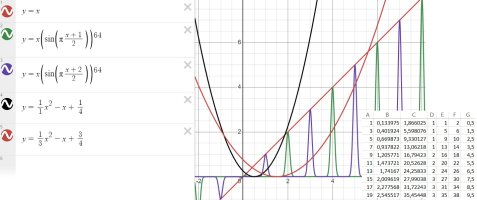[math]\mathrm{r}_{1}=\frac{2+\sqrt{3}}{2}n-\sqrt{3}n\\ \mathrm{r}_{2}=\frac{2-\sqrt{3}}{2}n+\sqrt{3}n\\ for\; \mathrm{n}_{1},\;\mathrm{n}_{2}\;(\in \mathrm{N}):\\ \mathrm{r}_{1}<\mathrm{n}_{1}<\mathrm{r}_{1}+1\\ \mathrm{r}_{2}>\mathrm{n}_{2}>\mathrm{r}_{2}-1\\ How\; to\; calculate\;\mathrm{n}_{1},\;\mathrm{n}_{2}?[/math]
You are using an out of date browser. It may not display this or other websites correctly.
You should upgrade or use an alternative browser.
You should upgrade or use an alternative browser.
calculating a natural number
- Thread starter Perdurat
- Start date
I give a bit more context :What are we allowed to use
the two sine functions have their maxima on f(x)=x and their minima on f(y)=0
one for the odd numbers, one for the even numbers
the 64 is arbitrairy but needs to be an even number, the higher the number, the closer the maxima are to (1,1),(2,2),(3,3),...
the parabola have their vertex on (1/2, 0), (3/2, 0), (5/2, 0), ...
and their focus point on f(x)=x/2
so the only parameter that defines the parabola is n (1,3,5,7,9, ...)->column A on the spreadsheet snippet
[math]\frac{1}{n}x^2-x+\frac{n}{4}[/math]column B: where f(x)=x enters the parabola, column C, where it leaves (r1 and r2)
column D: using the excel roundup(Bn;0), column E: using the excel rounddown(Cn;0)
column F = 2n (2*column A OR column B+column C OR column D+ column E)
f(y)=column G is the symmetry axis of the parabola
so I try to figure out for an arbitrairy big odd number:
how many "even peaks" there are within the parabola, left of the symmetry axis?
how many "even peaks" there are within the parabola, right of the symmetry axis?
how many "odd peaks" there are within the parabola left of the symmetry axis?
how many "odd peaks" there are within the parabola right of the symmetry axis?

